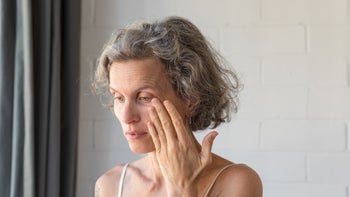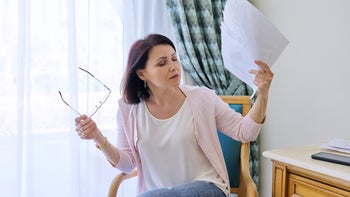
6 Best Exercises for Menopause Symptoms
Key takeaways:
Menopause is a natural process during which estrogen levels decline. This can lead to hot flashes, mood swings, sleep issues, and weight gain.
There are many benefits of exercising during menopause. These benefits include more muscle mass, stronger bones, boosted mood, better sleep, and improved sexual function.
The best types of exercise for menopause symptoms include strength training, aerobic conditioning, balance exercises (like yoga or tai chi), pelvic floor exercises, and breathing exercises.

Menopause marks an important transition in a woman’s life that brings both good changes, like no more periods, and not-so-good changes, such as hot flashes, weight gain, and mood swings. The good news is that there are several treatment options for menopause symptoms, including hormone replacement therapy (HRT).
According to experts, another way to manage menopause symptoms is through exercise. Research has found that there are specific types of exercise that can help women feel their best during and after this transition.
What are the best exercises for menopause symptoms?
In general, during menopause, it’s important to do exercises that you enjoy and will do regularly. But researchers have studied the effects of certain types of exercise in menopausal women. According to their findings, the following six types of exercise are the most beneficial for menopause symptoms.
1. Strength training
A 2023 review showed that strength training had many positive effects on menopause symptoms. It found that these exercises improved strength, bone density, heart rate, and blood pressure in menopausal women. The moves also increased lean muscle mass, which can increase metabolism.
Make it a goal to do a full-body strength training routine twice a week. Examples of some of the exercises you might incorporate include:
You can use free weights, resistance bands, or weight machines at the gym during your strength training routines. You can even use your own body weight, so you don’t even need equipment.
2. High-impact exercise
Although it's not for everyone, many women should also consider high-impact exercises. A 2023 review of studies found that high-intensity, high-impact exercises were good for bone density in postmenopausal women.
Examples of high-impact exercise include high-intensity interval training (HIIT) workouts, running, jumping rope, basketball, circuit training, and tennis. If you’re new to this type of exercise, it’s important to speak with your primary care provider first, to be sure it’s safe for you to try. People with osteoporosis and certain conditions like arthritis should avoid high-impact activities.
3. Cardio (aerobic exercise)
Aim to do moderate-intensity exercise at least 30 minutes a day, 5 days a week. This will burn calories, strengthen your cardiovascular system, and improve your blood pressure.
There are several types of cardio exercise. High-impact cardio exercises include running, jumping rope, and tennis. Lower-impact cardio exercises — like swimming, walking, dancing, and working out on an elliptical or stair-step machine — are easier on the joints.
If you aren’t sure where to start with cardio, walking is an excellent choice. Research suggests walking programs can help relieve menopause symptoms. You can start with just 15 minutes a day, and then work your way up to 30 minutes (or more). Make sure you are walking fast enough to get your heart pumping and maybe even work up a sweat.
4. Pelvic floor exercises
Don’t forget to exercise your pelvic floor! Research has shown pelvic floor exercises help improve sexual function, as well as bladder symptoms. Kegel exercises (squeezing and relaxing your pelvic floor muscles) are the most well-known way to strengthen this area. But there are also bladder training exercises that work your pelvic floor. As strengthening this area can sometimes be tricky, you can also see a pelvic floor physical therapist for help.
5. Tai chi, yoga, and pilates
Balance exercises can improve your stability and prevent falls. One great exercise is tai chi, which can be described as a combination of yoga (slow and sustained postures) and meditation. It not only helps improve balance, it increases flexibility and strengthens your muscles. The meditation component also helps relieve stress and anxiety.
Yoga is another exercise option to help ease menopause symptoms, especially those related to mood. Much like tai chi, yoga helps improve balance, flexibility, strength, and stress. The sustained postures also help improve core strength, as well as pelvic floor strength.
Pilates is another low-intensity exercise that improves strength, flexibility, and balance. It can be done on a special machine, called a reformer, or without the machine, called mat Pilates. A 2016 study found that an 8-week Pilates exercise program improved symptoms such as mood, hot flashes, and fatigue in postmenopausal women.
6. Relaxation exercises
According to the North American Menopause Society, relaxation exercises can also help with menopause symptoms. Activities such as deep breathing and meditation may help reduce stress and the severity of hot flashes. Practicing mindfulness regularly can also reduce stress and improve focus, among other mental health benefits.
What are the benefits of exercise for menopause?
You are probably aware of the general benefits of regular exercise. However, it is even more important to stay active as you age. Exercise can help lessen many of the most common menopause symptoms.
Here are some of the main benefits of exercise during menopause.
Improves heart health
The risk of cardiovascular disease increases during menopause. This is because estrogen, which declines during menopause, helps protect the heart.
Regular exercise can keep your heart healthy during and after menopause. It increases HDL (high-density lipoprotein, or “good”) cholesterol, reduces LDL (low-density lipoprotein, or “bad”) cholesterol, and reduces blood pressure. Exercise also reduces your risk of heart attack and stroke.
Increases bone mass
Since estrogen helps to keep your bones strong, declining levels also puts you at risk for osteoporosis. But you can protect your bone density with resistance exercises. Strength training or high-impact exercise (running or jumping rope, for example) can preserve and build up bone density.
Reduces depression symptoms and improves mood
Feeling anxious, depressed, or down? This is common during menopause because of — you guessed it — declining levels of estrogen. Experts theorize declining estrogen affects serotonin, a chemical that regulates your mood.
A 2021 study found that regular exercise can help boost the mood of postmenopausal women.
Improves sleep
Sleep disturbances and insomnia are common during menopause and can affect your quality of life. Being active, however, can help. A 2023 systematic review found that exercise can help improve sleep quality during menopause.
Improves sexual function
It’s common for women going through menopause to have weak pelvic floor muscles, which can affect sexual function. Pelvic floor exercises, like Kegels, strengthen these muscles. This can help improve sexual function, according to a 2017 randomized clinical trial.
Improves bladder control
Weaker pelvic floor muscles can also lead to bladder issues, such as urinary incontinence, during menopause. Improving your pelvic floor strength with exercises can help improve your bladder control.
Prevents menopause-related weight changes
Many women notice changes in their weight and shape during menopause. One big cause of this is that, after the age of 30, muscle mass decreases by about ½ lb each year. You can preserve and even gain muscle mass by doing strength or resistance training, however.
In addition to weight changes, one of the more bothersome menopause symptoms is hot flashes. Unfortunately, a Cochrane review concluded that there was not enough evidence to show that exercise helped reduce hot flashes or night sweats in menopausal women. Other treatments for hot flashes, such as hormone replacement therapy (HRT), may be more effective for managing symptoms.
Are there any exercises to avoid during menopause?
People with certain health conditions should avoid some exercises during menopause. For example, it’s best for people with osteoporosis to avoid high-impact exercises. If you have high blood pressure or another heart condition, talk to your doctor before starting an exercise program. You want to be sure your heart is ready to take on more activity.
If you have pain or discomfort with any exercise, stop what you’re doing and talk to a professional. This is also true if you have chest pain, severe shortness of breath, nausea or vomiting, or dizziness. It’s important to listen to your body and not overdo it. Generally, this means starting slowly and gradually increasing the duration and intensity of your workouts. It’s also a good idea to talk to your primary care provider about your target heart rate.
The bottom line
Menopause is a natural stage in which a woman’s body gradually makes less estrogen. The hormone changes during menopause cause unpleasant symptoms, including hot flashes, sleep disturbances, sexual dysfunction, and mood changes. Exercise, including strength training and cardio, can help relieve these physical symptoms. Balance and meditative exercises, like yoga, Pilates, and tai chi, can be beneficial both physically and mentally.
Why trust our experts?



References
Alblooshi, S., et al. (2023). Does menopause elevate the risk for developing depression and anxiety? Results from a systematic review. Australasian Psychiatry.
Capel-Alcaraz, A. M., et al. (2023). The efficacy of strength exercises for reducing the symptoms of menopause: A systematic review. Journal of Clinical Medicine.
Daley, A., et al. (2014). Exercise for vasomotor menopausal symptoms. Cochrane Database of Systematic Reviews.
Johnson, A., et al. (2019). Complementary and alternative medicine for menopause. Journal of Evidence-Based Integrative Medicine.
Lee, H., et al. (2016). Effects of 8-week Pilates exercise program on menopausal symptoms and lumbar strength and flexibility in postmenopausal women. Journal of Exercise Rehabilitation.
López-Pérez, M. P., et al. (2023). Pelvic floor muscle exercises as a treatment for urinary incontinence in postmenopausal women: A systematic review of randomized controlled trials. Healthcare.
Manaye, S., et al. (2023). The role of high-intensity and high-impact exercises in improving bone health in postmenopausal women: A systematic review. Cureus.
National Center for Complementary and Integrative Health. (2023). Tai chi: What you need to know.
Nazarpour, S., et al. (2017). Effects of sex education and kegel exercises on the sexual function of postmenopausal women: A randomized clinical trial. The Journal of Sexual Medicine.
Qian, J., et al. (2023). The effect of exercise intervention on improving sleep in menopausal women: A systematic review and meta-analysis. Frontiers in Medicine.
The North American Menopause Society. (n.d.). What you should know about relaxation techniques for hot flashes.
Volpi, E., et al. (2004). Muscle tissue changes with aging. Current Opinion in Clinical Nutrition and Metabolic Care.
Williamson, L. (2023). The connection between menopause and cardiovascular disease risks. American Heart Association.
Yılmaz, S., et al. (2021). The effect of physical activity and depressive mood on menopausal symptoms in postmenopausal women. International Journal of Clinical Practice.

























